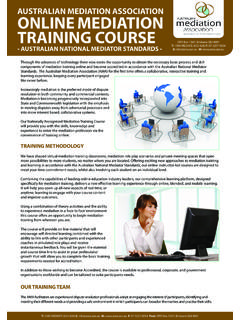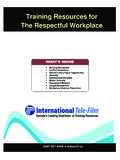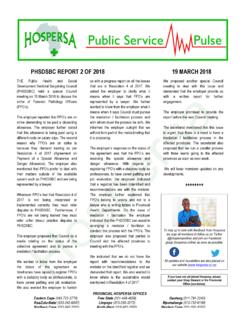Transcription of Successful interventions with hard to reach groups
1 Successful interventions with hard TO reach groups 1 INTRODUCTION About the project The project was set up in January 2004 as a result of discussions at an SCS event, to find quick ways to improve how HSE targets hard to reach groups . This resultant report is based on responses to a questionnaire by HSE staff; discussions with workplace contact teams; scrutiny of a wide range of HSE research and internal reports; and a trawl of documents available on the Internet. It contains information and recommendations about identifying hard to reach groups , and the ingredients of Successful interventions . Recommendations are wide ranging and include suggestions for improving HSE activities and expertise, and ideas for further exploration. Main issues HSE needs to be clear about which groups it targets and what it wants to achieve through these new approaches Staff look to the centre for a steer on these issues.
2 There is a case for focussing most activity away from the hard to reach groups themselves to focus on intermediaries, to take forward the HSC/E strategy. For example even the impressive achievement of getting 8,500 people to attend awareness events in 2003/4 is a drop in the ocean in reaching the million small businesses that exist. Successful interventions respond to the needs, characteristics, and local circumstances of the hard to reach group,. The project has developed a tool that helps to analyse characteristics, and so transfer Successful approaches to disparate groups . HSE has insufficient information about the effectiveness of the new interventions , except awareness events where there is enough to confirm their value and impact. A more systematic testing and evaluation of other approaches needs to be done, and the results shared.
3 However there is a large amount of seemingly under-utilised research into particular hard to reach groups . This needs to be assimilated, so a pause in any further research is recommended. Sandra Whitnell Social Inclusion Policy Branch April 2004 Successful interventions with hard TO reach groups 2 Contents Para SUMMARY Project aims and output Methodology Outputs SUMMARY OF RECOMMENDATIONS hard TO reach groups Who are they? From groups to characteristics Identifying characteristics: a model Developing contact with hard to reach groups Learning from one another Successful interventions Current state of play Maximising impact Type and range of interventions Awareness Events Using events for consultation Awareness of web based information Partnerships Sector and industry wide initiatives Pump priming Best practice Developing intelligent customers Evaluating interventions RESUME OF RELATED HSE RESEARCH Use of research WS Atkins: summaries of research INDEX TO SELECTED RESEARCH REPORTS REVIEWED BY ATKINS BIBLIOGRAPHY TABLES/FIGURES 1 Working with hard to reach groups .
4 Lessons from others experiences 2 Specific groups identified by HSE staff 3 Tool to identify characteristics of the hard to reach 4 Diagrammatic version of the tool 5 A worked example of the tool 6 Agricultural SADs: maximising impact ANNEXES (separate files) 1 Project plan 2 Summary of relevant research reports extracted from the WS Atkins review 1 4 6 15 16 18 20 22 28 30 33 35 39 49 50 51 56 64 65 67 68 70 71 17 17 21 21 21 41 Successful interventions with hard TO reach groups 3 SUMMARY Project aims and outputs 1 The main aim of the project is to improve the efficiency and effectiveness of interventions aimed at the hard to reach groups that are most at risk, optimising synergy, and avoiding duplication. The main output is a report with recommendations, which makes a significant contribution to the new 'new levers' programme.
5 2 The full project plan and associated questionnaire is included at annex a. Methodology 3 A semi-structured questionnaire and the project plan were circulated, prompting meetings and written responses from groups and individuals. The project is grateful to HSE staff who were without exception generous providers of information and views. As well as responding directly to the questionnaire, staff sent articles, reports etc and provided helpful signposting to other documents, which were used in this report. The questionnaire was in itself seen by some respondents as a useful aid to planning. 4 The project also reviewed the available research; intranet and internet searches were also used. Outputs Characteristics of the hard to reach . (paras 16-29) 5 The project set out to elicit views of staff about which groups they find hard to reach , rather than impose a pre selected list.
6 This has been achieved, and a summary table is provided in the report (table 2). Very few respondents identified those hardest to reach and most at risk , except for very specific sub groups , eg. Self employed elderly farmers. Staff tend to look to central guidance eg sectors or policy units to identify their target audiences. 6 The report discusses the benefits of identifying the characteristics of hard to reach groups . Research identified a number of possible approaches. A major product of the project has been the development of a holistic model that encompasses demographic, cultural, behavioural, attitudinal and administrative characteristics. 7 At the suggestion of FOD SIU the model is being developed as a tool (tables 3-5) to help to identify the group or groups that HSE may wish to target, and prompt new ideas for strategies for particular groups .
7 It has been tested with workplace contact teams who found it useful. Successful interventions with hard TO reach groups 4 Summary of interventions (paras 30 69) 8 The project plan outlined the interventions that were likely to be in scope, and the project was able to identify some information relating to most of them. Case studies are provided, highlighting significant success factors and learning points. 9 Between them, many field staff and policy staff have a great deal of experience of a wide range of interventions . More people in all parts of HSE are becoming involved in all types of innovative interventions . We need to use these experiences to help manage and gain full benefit from them. Different attempts have been made by evaluators to measure impact, costs and benefits. The different approaches could usefully be bought together to provide a coherent and consistent model.
8 10 Awareness events were the most common interventions identified. HSE has confirmation through evaluation that they are effective in stimulating activity by participants. The report highlights significant success factors including trust, targeting, and interactive content. A multi pronged approach seems essential. Such events are more than awareness raising a lot of practical advice and activities take place, and it is hard to draw a dividing line between awareness, training and education. Most events were a mixture of approaches and some of these are described in the report. HSE could use these events to test ideas and to consult groups . 11 At the start of the current project it was expected that there was some work being duplicated that could be bought together or stopped. Nothing was identified from responses from HSE staff, and no research was found recommending that any particular activities or interventions should stop.
9 However there is scope to bring together the development of some assessment tools, and to improve learning between projects of a similar nature. WS Atkins(11) commented that it was noticeable that ideas generated by project activity are not always fed back into HSE. 12 Staff are excited by new opportunities, and keen to try new approaches, but it is often only by chance that they get to hear about others experience. The need to concentrate more on what works, and share information better, became a recurring theme in the responses from HSE staff. Many would welcome a more structured approach to testing interventions , and more opportunities to discover and share experience. The report makes recommendations in these areas. R sum of related HSE research (paras 70-72) 13 A pause in commissioning any further research on hard to reach groups is recommended until current studies have been disseminated.
10 There is evidence that some research has been commissioned inadvertently because of a lack of knowledge about previous work. 14 WS Atkins produced an assessment of research against HSE s strategy on small businesses. As part of this, they reviewed and summarised 127 research reports Successful interventions with hard TO reach groups 5and other documents. The project has reviewed these summaries and selected those most relevant to this subject (Annex B). An index to the summaries has been developed, which highlights reports that deal with particular interventions or groups , to help facilitate access to the research. A bibliography of other source material such as internal evaluations is also provided. Successful interventions with hard TO reach groups 6 SUMMARY OF RECOMMENDATIONS 15 The recommendations cover three areas: improving HSE activities, improving HSE expertise, and suggestions for further exploration.














